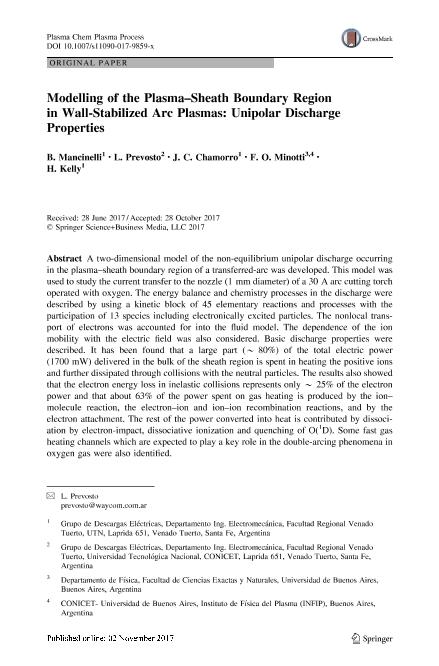Artículo
Modelling of the Plasma–Sheath Boundary Region in Wall-Stabilized Arc Plasmas: Unipolar Discharge Properties
Mancinelli, Beatriz Rosa; Prevosto, Leandro ; Chamorro Garcés, Juan Camilo
; Chamorro Garcés, Juan Camilo ; Minotti, Fernando Oscar
; Minotti, Fernando Oscar ; Kelly, Hector Juan
; Kelly, Hector Juan
 ; Chamorro Garcés, Juan Camilo
; Chamorro Garcés, Juan Camilo ; Minotti, Fernando Oscar
; Minotti, Fernando Oscar ; Kelly, Hector Juan
; Kelly, Hector Juan
Fecha de publicación:
01/2018
Editorial:
Springer
Revista:
Plasma Chemistry And Plasma Processing
ISSN:
0272-4324
Idioma:
Inglés
Tipo de recurso:
Artículo publicado
Clasificación temática:
Resumen
A two-dimensional model of the non-equilibrium unipolar discharge occurring in the plasma–sheath boundary region of a transferred-arc was developed. This model was used to study the current transfer to the nozzle (1 mm diameter) of a 30 A arc cutting torch operated with oxygen. The energy balance and chemistry processes in the discharge were described by using a kinetic block of 45 elementary reactions and processes with the participation of 13 species including electronically excited particles. The nonlocal transport of electrons was accounted for into the fluid model. The dependence of the ion mobility with the electric field was also considered. Basic discharge properties were described. It has been found that a large part (~ 80%) of the total electric power (1700 mW) delivered in the bulk of the sheath region is spent in heating the positive ions and further dissipated through collisions with the neutral particles. The results also showed that the electron energy loss in inelastic collisions represents only ~ 25% of the electron power and that about 63% of the power spent on gas heating is produced by the ion–molecule reaction, the electron–ion and ion–ion recombination reactions, and by the electron attachment. The rest of the power converted into heat is contributed by dissociation by electron-impact, dissociative ionization and quenching of O(1D). Some fast gas heating channels which are expected to play a key role in the double-arcing phenomena in oxygen gas were also identified.
Palabras clave:
Plasma&Ndash;Sheath
,
Unipolar Discharge
,
Wall-Stabilized Arc
Archivos asociados
Licencia
Identificadores
Colecciones
Articulos(CCT - SANTA FE)
Articulos de CTRO.CIENTIFICO TECNOL.CONICET - SANTA FE
Articulos de CTRO.CIENTIFICO TECNOL.CONICET - SANTA FE
Citación
Mancinelli, Beatriz Rosa; Prevosto, Leandro; Chamorro Garcés, Juan Camilo; Minotti, Fernando Oscar; Kelly, Hector Juan; Modelling of the Plasma–Sheath Boundary Region in Wall-Stabilized Arc Plasmas: Unipolar Discharge Properties; Springer; Plasma Chemistry And Plasma Processing; 38; 1; 1-2018; 147-176
Compartir
Altmétricas



